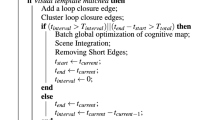Abstract
Efficient encoding of visual information is essential to the success of vision-based navigation tasks in large-scale environments. To do so, we propose in this article the Sparse Max-Pi neural network (SMP), a novel compute-efficient model of visual localization based on sparse and topological encoding of visual information. Inspired by the spatial cognition of mammals, the model uses a “topologic sparse dictionary” to efficiently compress the visual information of a landmark, allowing rich visual information to be represented with very small codes. This descriptor, inspired by the neurons in the primary visual cortex (V1), are learned using sparse coding, homeostasis and self-organising map mechanisms. Evaluated in cross-validation on the Oxford-car dataset, our experimental results show that the SMP model is competitive with the state of the art. It thus provides comparable or better performance than CoHog and NetVlad, two state-of-the-art VPR models.
Access this chapter
Tax calculation will be finalised at checkout
Purchases are for personal use only
Similar content being viewed by others
Notes
- 1.
Absolute orientation can be obtained from a magnetic or visual compass [2].
- 2.
The model must compare the current image with all images stored in memory to localize a place. The smaller the code, the faster the memory search.
- 3.
To facilitate the notation of the dictionary configuration used during an experiment, the SMP model using a dictionary of size \(n*n\) is called \(SMP-n\).
- 4.
The NetVlad model run at an average frequency of 0.05 Hz with one CPU.
References
Arandjelović, R., Gronat, P., Torii, A., Pajdla, T., Sivic, J.: NetVLAD: CNN architecture for weakly supervsied place recognition. ar**v:1511.07247, May 2016
Colomer, S., Cuperlier, N., Bresson, G., Gaussier, P., Romain, O.: LPMP: a bio-inspired model for visual localization in challenging environments. Front. Robot. AI 8 (2022)
Colomer, S., Cuperlier, N., Bresson, G., Romain, O.: Forming a sparse representation for visual place recognition using a neurorobotic approach. In: 2021 IEEE International Intelligent Transportation Systems Conference (ITSC), pp. 3002–3009 (2021)
Geva-Sagiv, M., Las, L., Yovel, Y., Ulanovsky, N.: Spatial cognition in bats and rats: from sensory acqusiition to multsicale maps and navigation. Nat. Rev. Neurosci. 16, 94–108 (2015). https://doi.org/10.1038/nrn3888
Maddern, W., Pascoe, G., Linegar, C., Newman, P.: 1 year, 1000km: the oxford RobotCar dataset. Int. J. Robot. Res. (IJRR) 36, 3–15 (2017)
Olshausen, B., Field, D.: Sparse coding of sensory inputs. Curr. Opin. Neurobiol. 14, 481–487 (2004). https://doi.org/10.1016/j.conb.2004.07.007
Perrinet, L.U.: An adaptive homeostatic algorithm for the unsupervsied learning of visual features. Vision 3(3), 47 (2019). https://doi.org/10.3390/vsiion3030047
Rolls, E.T., Wirth, S.: Spatial representations in the primate hippocampus, and their functions in memory and navigation. Prog. Neurobiol. 171, 90–113 (2018)
Serre, T., Wolf, L., Bileschi, S., Riesenhuber, M., Poggio, T.: Robust object recognition with cortex-like mechansims. IEEE Trans. Pattern Anal. Mach. Intell. 29, 411–426 (2007). https://doi.org/10.1109/TPAMI.2007.56
Willmore, B., Tolhurst, D.: Characterizing the sparseness of neural codes. Netw. Comput. Neural Syst. 12(3), 255–270 (2001)
Yurtsever, E., Lambert, J., Carballo, A., Takeda, K.: A survey of autonomous driving: common practices and emerging technologies. IEEE Access 8, 58443–58469 (2020). https://doi.org/10.1109/ACCESS.2020.2983149
Zaffar, M., Ehsan, S., Milford, M., McDonald-Maier, K.: CoHOG: a light-weight, compute-efficient, and training-free visual place recognition technique for changing environments. IEEE Robot. Autom. Lett. 5, 1835–1842 (2020)
Author information
Authors and Affiliations
Corresponding author
Editor information
Editors and Affiliations
Rights and permissions
Copyright information
© 2022 The Author(s), under exclusive license to Springer Nature Switzerland AG
About this paper
Cite this paper
Colomer, S., Cuperlier, N., Bresson, G., Pechberti, S., Romain, O. (2022). Sparse and Topological Coding for Visual Localization of Autonomous Vehicles. In: Cañamero, L., Gaussier, P., Wilson, M., Boucenna, S., Cuperlier, N. (eds) From Animals to Animats 16. SAB 2022. Lecture Notes in Computer Science(), vol 13499. Springer, Cham. https://doi.org/10.1007/978-3-031-16770-6_13
Download citation
DOI: https://doi.org/10.1007/978-3-031-16770-6_13
Published:
Publisher Name: Springer, Cham
Print ISBN: 978-3-031-16769-0
Online ISBN: 978-3-031-16770-6
eBook Packages: Computer ScienceComputer Science (R0)




